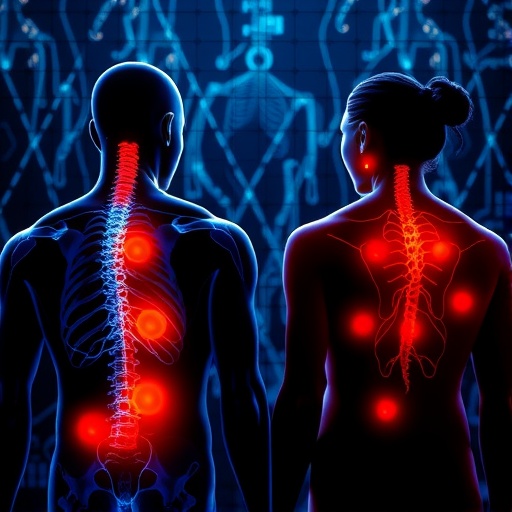In a groundbreaking study set to reshape our understanding of pain perception, researchers Chaudhry, Coovadia, and Schwende have investigated the complexities of sex differences in the relationship between pain and autonomic outflow, using the cold pressor test as a pivotal tool. Pain, a universal human experience, can manifest in myriad ways, and the nuances of how men and women process this physical sensation have garnered significant interest. What emerges from their research is a compelling narrative that might unravel the distinct physiological responses that differentiate the sexes during pain exposure.
The cold pressor test involves immersing the hand in icy water for a designated period. This straightforward yet enlightening approach elicits a reflexive response that activates the sympathetic nervous system, leading to changes in heart rate and blood pressure. This technique not only provides insight into pain thresholds but also enables researchers to study the autonomic nervous system’s role during painful stimuli. With gender differences being a focal point, the implications of their findings extend beyond mere academic interest.
Previous studies have suggested that females may have a heightened sensitivity to pain compared to their male counterparts. However, the findings of Chaudhry et al. introduce a layer of complexity. Not only do they explore pain sensitivity, but they also delve into the autonomic responses, which include heart rate variability and skin temperature regulation—factors intricately tied to how pain is perceived. This multidimensional approach allows for a more comprehensive understanding of pain that factors in both psychological and physiological dimensions.
Utilizing a diverse participant pool, the researchers employed rigorous methodologies to ensure that their results were robust and broadly applicable. The study involved both men and women, who were subjected to the cold pressor test while their autonomic responses were meticulously monitored. These measurements included heart rate, blood pressure, and even skin conductance, all of which provided a window into the participants’ sympathetic nervous system activity.
What sets this research apart is its commitment to a detailed analysis of how these autonomic responses vary by sex. The sex differences observed in pain perception are not merely anecdotal but rooted in measurable physiological indicators. For instance, the study reveals that women exhibited shifted autonomic outflow responses, which could correlate with their greater pain experience. Such findings challenge traditional notions that a universal model of pain exists, suggesting instead that sex-specific treatment approaches may be necessary in clinical settings.
Additionally, the researchers provided insights into the hormonal influences that may underpin these observed differences. The menstrual cycle, for instance, has been shown to impact pain perception in women. Acknowledging the interplay between hormonal fluctuations and pain sensitivity adds a further dimension to understanding how individuals might experience pain differently based on biological sex. This detail emphasizes the necessity for controlled measures in future studies to account for these cyclical variations in research designs.
The implications of this study resonate in clinical practices as well. Pain management strategies often fail to recognize the nuances of how sex influences pain experiences. By arming practitioners with the insights gleaned from this research, more individualized treatment plans can be developed, tailored to the patient’s specific physiological and psychological needs. The hope is that such personalized approaches will enhance treatment efficacy for those suffering from chronic pain conditions, which, statistics show, affect millions worldwide.
Moreover, the findings prompt larger discussions about societal expectations and the stigmas surrounding pain. Societies often mold perceptions of masculinity and femininity, affecting how individuals report and react to pain. The researchers’ work serves as a crucial reminder that pain is not merely a biological phenomenon but a complex interplay of physiological, psychological, and sociocultural factors. This recognition can foster a more empathetic approach to treating individuals across the gender spectrum.
As we advance our understanding of sex differences in pain and autonomic responses, it is vital to consider future research that builds upon this foundation. Longitudinal studies that explore these differences over time or across various life stages could provide deeper insights. The temporal nature of pain, influenced by various factors such as aging, stress, and health conditions, may yield important data that could reshape treatment methodologies.
Furthermore, the impact of environment related to pain experiences should not be underestimated. Stressors, both acute and chronic, may exacerbate pain symptoms and alter autonomic responses. It’s crucial that subsequent studies incorporate these environmental variables, potentially leading to a holistic view of pain management that encompasses not only biological but also psychological and ecological perspectives.
In conclusion, the timely and innovative findings presented by Chaudhry and colleagues in their investigation of sex differences in autonomic responses during pain exposure offer the scientific community a fresh lens through which to view the complexities of pain. As our understanding deepens, clinicians, researchers, and patients alike stand to benefit from the improved frameworks for navigating pain treatment and management. Their work offers a promising avenue to create more equitable and effective healthcare strategies tailored to the diverse array of pain experiences influenced by sex and gender.
This research is not just an exploration of pain; it’s an invitation to rethink our assumptions about how sex influences our very experience of discomfort. By shedding light on these critical differences in pain perception, the study undoubtedly paves the way for future inquiries to advance both the scientific understanding and the practical approaches to pain management across gender lines.
Subject of Research: Sex differences in the relationship between pain and autonomic outflow during a cold pressor test.
Article Title: Sex differences in the relationship between pain and autonomic outflow during a cold pressor test.
Article References:
Chaudhry, L.A., Coovadia, Y., Schwende, B.K. et al. Sex differences in the relationship between pain and autonomic outflow during a cold pressor test.
Biol Sex Differ 16, 60 (2025). https://doi.org/10.1186/s13293-025-00743-2
Image Credits: AI Generated
DOI: 10.1186/s13293-025-00743-2
Keywords: Pain perception, autonomic nervous system, sex differences, cold pressor test, pain management.




